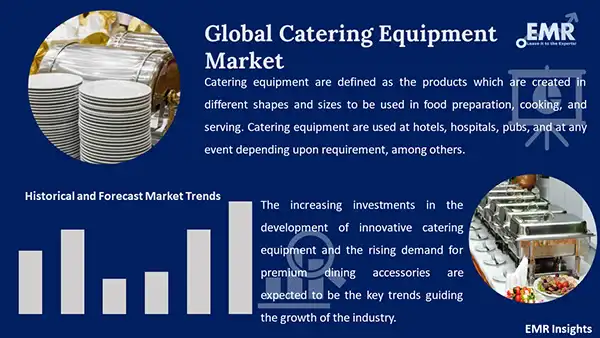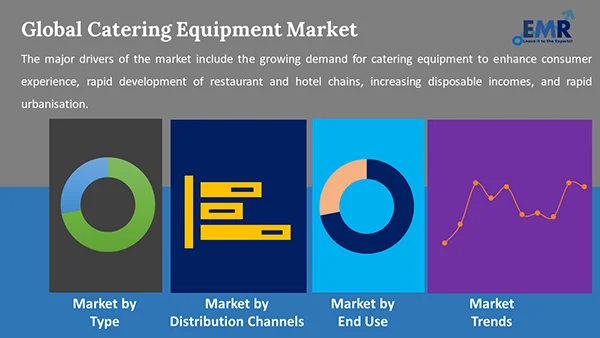
Consumer Insights
Uncover trends and behaviors shaping consumer choices today
Procurement Insights
Optimize your sourcing strategy with key market data
Industry Stats
Stay ahead with the latest trends and market analysis.
The global catering equipment market is projected to grow by 5.40% between 2026 and 2035.
Base Year
Historical Period
Forecast Period
The California Restaurant Association emphasizes restaurants' economic role in the Far West, creating jobs and advancing careers across 83,501 establishments.
The National Restaurant Association predicts the food service industry will achieve $1 trillion in sales by 2024, stimulating the market's demand.
The USDA reports Australia has 65,866 independent and chain restaurants, providing a diverse consumer foodservice landscape.
Compound Annual Growth Rate
5.4%
2026-2035
*this image is indicative*
Catering equipment is crucial for the efficient and effective preparation, cooking, and serving of food in various settings, from large-scale events to intimate gatherings. The catering equipment market has been driven by its use in weddings, gatherings, full-service restaurants and hotels, and others. The use of catering equipment streamlines the process of managing food for events, ensuring operational efficiency, safety, and quality from preparation through to service.
By utilizing this equipment, catering teams deliver high-quality food and service at weddings, ensuring that all culinary aspects of the event are handled professionally, efficiently, and safely. The US marriage rate increased to 6.0 per 1,000 in 2021, up from 5.1 per 1,000 in 2020, consequently driving higher demand in the catering equipment market.

Read more about this report - REQUEST FREE SAMPLE COPY IN PDF
Rapid developments in restaurant chains and hotels, rising demand for premium dining accessories, increasing modularity, and innovative catering equipment are the major trends impacting global catering equipment market growth.
Increasing demand for compact kitchens drives the popularity of modular, space-saving catering equipment like stackable appliances and multifunctional stations, maximizing efficiency and scalability in commercial kitchens.
Restaurants and hotels expand their operations and investments creating a need for additional modern and efficient catering equipment to support increased food production, storage, and service capacities while enhancing productivity and streamlining operations.
The advancements in catering equipment often integrate smart technologies and automation features that streamline operational processes empowering businesses to operate more efficiently.
There is a growing demand for high-quality and aesthetically pleasing tableware, glassware, and serving utensils leading to necessitating investments in high-quality equipment to meet elevating consumer preferences.
The growing developments in restaurant chains and hotels drive demand for modern, efficient equipment, enhancing productivity and scalability while creating a demand for modular catering equipment that meets the demand for compact kitchens, with stackable appliances and multifunctional stations optimizing space and efficiency.
Catering equipment manufacturers prioritize energy efficiency and eco-friendliness, utilizing energy-efficient cooking appliances, waste reduction tech, and sustainable materials. This focus aims to minimize environmental impact while lowering operating costs, aligning with sustainability goals in the food service industry.

Read more about this report - REQUEST FREE SAMPLE COPY IN PDF
“Catering Equipment Market Report and Forecast 2026-2035” offers a detailed analysis of the market based on the following segments:
Market Breakup by Type
Market Breakup by End Use
Market Breakup by Distribution Channels
Market Breakup by Region
Food handling equipment is widely used as it plays a fundamental role in maintaining food safety, operational efficiency, and customer satisfaction in catering and food service businesses.
It ensures food safety by meeting hygiene standards, enhancing efficiency in preparation and storage, and aiding compliance with regulations. It preserves food quality, boosts customer satisfaction, and offers versatility for various operations while providing streamlined workflows to maintain freshness.
The rapid expansion of quick-service restaurants and high-end restaurant chains is significantly contributing to the catering equipment market growth.
The expansion of catering services can be linked to the advancement in living standards and fast urbanization, particularly in emerging economies. The market is expected to experience growth in the forecast period due to a surge in the demand for visually appealing catering equipment for family gatherings and festive occasions. This trend is driving the popularity of innovative catering accessories crafted from materials like ceramics.
The increasing dine-out activities in hotels, pubs, bars, and restaurants are driving the demand for catering equipment, further fueling the market growth. Moreover, the market is likely to benefit from the increasing accessibility of high-quality catering equipment through online platforms.
The market in the Asia Pacific is being propelled by the swift expansion of restaurant chains and hotels in the region. This growth is due to significant investments in enhancing infrastructure within the hospitality sector, driven by a robust economy, increasing population, and rising disposable incomes. Catering accessories such as holding cabinets, chafing dishes, food pan carriers, catering carts, hot/cold beverage bins, and insulated beverage carriers, among others, are utilised extensively in the food and hospitality industry.
Additionally, the increasing adoption of catering equipment by street food stalls, snack vans, and roadside food shops in the region is expected to further support market growth during the forecast period.
The company designs, manufactures, and provides food service equipment such as commercial and industrial kitchen equipment for commercial kitchens, bakeries, delis, and grocery stores around the globe.
Founded in 1912, with its headquarters in the United States, ITW Food Equipment Group provides its products to commercial kitchens, bakeries, delis, and grocery stores around the globe.
Founded in 1864, with its headquarters in the United States, Welbilt, Inc. designs, manufactures, and provides food service equipment for the global commercial food service market.
Founded in 1973, with its headquarters in Germany, Rational AG, specializes in the production and sale of commercial and industrial kitchen equipment designed for thermal food preparation.
Founded in 1971, with its headquarters in the United Kingdom, Lincat stands as a premier global provider of commercial catering equipment, renowned for its comprehensive range of products catering to cooking, holding, and display needs.
*Please note that this is only a partial list; the complete list of key players is available in the full report. Additionally, the list of key players can be customized to better suit your needs.*
Other global catering equipment market key players are Winterhalter Gastronom GmbH, Hoshizaki Corporation, Jestic Limited, MEIKO Maschinenbau GmbH & Co KG, Sammic S.L., and Maxima - Spangenberg International B.V., among others.




*While we strive to always give you current and accurate information, the numbers depicted on the website are indicative and may differ from the actual numbers in the main report. At Expert Market Research, we aim to bring you the latest insights and trends in the market. Using our analyses and forecasts, stakeholders can understand the market dynamics, navigate challenges, and capitalize on opportunities to make data-driven strategic decisions.*
Get in touch with us for a customized solution tailored to your unique requirements and save upto 35%!
The market is projected to grow at a CAGR of 5.40% between 2026 and 2035.
The market is categorised according to the type, which includes food handling equipment, cleaning equipment, catering accessories, and others.
The market key players are ITW Food Equipment Group, Welbilt, Inc., RATIONAL Aktiengesellschaft, Lincat Limited, Winterhalter Gastronom GmbH, Hoshizaki Corporation, Jestic Limited, MEIKO Maschinenbau GmbH & Co KG, Sammic S.L., and Maxima - Spangenberg International B.V., among others.
Based on the end use, the market is divided into full-service restaurants and hotels, quick-service restaurants, caterers, and others.
Based on the distribution channels, the market is divided into offline and online.
The market is broken down into North America, Europe, Asia Pacific, Latin America, and Middle East and Africa.
Explore our key highlights of the report and gain a concise overview of key findings, trends, and actionable insights that will empower your strategic decisions.
| REPORT FEATURES | DETAILS |
| Base Year | 2025 |
| Historical Period | 2019-2025 |
| Forecast Period | 2026-2035 |
| Scope of the Report |
Historical and Forecast Trends, Industry Drivers and Constraints, Historical and Forecast Market Analysis by Segment:
|
| Breakup by Type |
|
| Breakup by End Use |
|
| Breakup by Distribution Channels |
|
| Breakup by Region |
|
| Market Dynamics |
|
| Competitive Landscape |
|
| Companies Covered |
|
| Report Price and Purchase Option | Explore our purchase options that are best suited to your resources and industry needs. |
| Delivery Format | Delivered as an attached PDF and Excel through email, with an option of receiving an editable PPT, according to the purchase option. |
Datasheet
One User
USD 2,499
USD 2,249
tax inclusive*
Single User License
One User
USD 3,999
USD 3,599
tax inclusive*
Five User License
Five User
USD 4,999
USD 4,249
tax inclusive*
Corporate License
Unlimited Users
USD 5,999
USD 5,099
tax inclusive*
*Please note that the prices mentioned below are starting prices for each bundle type. Kindly contact our team for further details.*
Flash Bundle
Small Business Bundle
Growth Bundle
Enterprise Bundle
*Please note that the prices mentioned below are starting prices for each bundle type. Kindly contact our team for further details.*
Flash Bundle
Number of Reports: 3
20%
tax inclusive*
Small Business Bundle
Number of Reports: 5
25%
tax inclusive*
Growth Bundle
Number of Reports: 8
30%
tax inclusive*
Enterprise Bundle
Number of Reports: 10
35%
tax inclusive*
How To Order

Select License Type
Choose the right license for your needs and access rights.

Click on ‘Buy Now’
Add the report to your cart with one click and proceed to register.

Select Mode of Payment
Choose a payment option for a secure checkout. You will be redirected accordingly.
Gain insights to stay ahead and seize opportunities.

Get insights & trends for a competitive edge.

Track prices with detailed trend reports.

Analyse trade data for supply chain insights.

Leverage cost reports for smart savings

Enhance supply chain with partnerships.

Connect For More Information
Our expert team of analysts will offer full support and resolve any queries regarding the report, before and after the purchase.
Our expert team of analysts will offer full support and resolve any queries regarding the report, before and after the purchase.
We employ meticulous research methods, blending advanced analytics and expert insights to deliver accurate, actionable industry intelligence, staying ahead of competitors.
Our skilled analysts offer unparalleled competitive advantage with detailed insights on current and emerging markets, ensuring your strategic edge.
We offer an in-depth yet simplified presentation of industry insights and analysis to meet your specific requirements effectively.
Share